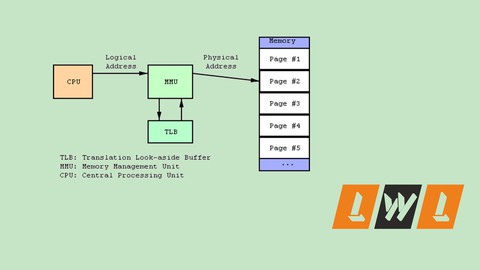
Memory Management in Linux Kernel
Memory Management in Linux Kernel, available at $39.99, has an average rating of 4.23, with 44 lectures, based on 155 reviews, and has 1480 subscribers.
You will learn about Knowledge of Memory management in Linux Kernel This course is ideal for individuals who are Developers curious about learning memory management in Linux Kernel It is particularly useful for Developers curious about learning memory management in Linux Kernel.
Enroll now: Memory Management in Linux Kernel
Summary
Title: Memory Management in Linux Kernel
Price: $39.99
Average Rating: 4.23
Number of Lectures: 44
Number of Published Lectures: 44
Number of Curriculum Items: 44
Number of Published Curriculum Objects: 44
Original Price: $27.99
Quality Status: approved
Status: Live
What You Will Learn
- Knowledge of Memory management in Linux Kernel
Who Should Attend
- Developers curious about learning memory management in Linux Kernel
Target Audiences
- Developers curious about learning memory management in Linux Kernel
Update: 16th Oct 2020: Added Notes/Examples used in the course
What will you learn from this course?
-
Physical Address space of processor and how to view it in Linux
-
Virtual Address space of processor
-
Kernel and User space virtual address space
-
Pages and Page Fault
-
How to convert virtual address into physical address and the format specifiers used to print
-
Low Memory and High Memory
-
Memory Allocation Mechanism – Buddy Allocator
-
Zones – /proc/buddyinfo
-
Dynamic Memory Allocation in Linux Kernel
-
Various flags used in kmalloc – GFP_KERNEL, GFP_ATOMIC, GFP_DMA
-
Differences between kmalloc and vmalloc
-
What happens when you pass 0 in kmalloc and vmalloc
-
Kernel Stack
API’s covered in this course:
-
virt_to_phys
-
phys_to_virt
-
kmalloc
-
kfree
-
krealloc
-
ksize
-
vmalloc
-
vfree
Commands used in this course:
-
qemu-system-x86
Course Curriculum
Chapter 1: Memory Management Part 1
Lecture 1: What is Physical Address Space
Lecture 2: How to view memory map/physical address space in Linux – /proc/iomem
Lecture 3: Running 32-bit Buildroot image in QEMU
Lecture 4: View/Change RAM Size in QEMU – /proc/meminfo, free -m
Lecture 5: Virtual Address Space for 32-bit processors
Lecture 6: Why kernel shares its address space for all processes
Lecture 7: 64-bit Memory Map
Lecture 8: Converting Virtual address to physical address and vice versa
Lecture 9: Pages – PAGE_SIZE macro
Lecture 10: struct page
Lecture 11: Page Fault
Lecture 12: Page Faults when memory is 4 KB
Lecture 13: User space virtual address space
Lecture 14: Kernel Virtual address space – low mem and high mem
Lecture 15: Low Memory
Lecture 16: How can i find out how much is my low mem and high mem
Lecture 17: High Memory
Lecture 18: Memory Allocation Mechanism
Lecture 19: kmalloc and kfree
Lecture 20: Linux Kernel Module example of kmalloc and kfree
Chapter 2: Memory Management Part 2
Lecture 1: Zones
Lecture 2: Buddy System allocator
Lecture 3: Virtual Kernel Memory Layout
Lecture 4: Can i use virt_to_phy to get physical address of kmalloc pointer
Lecture 5: Example of passing various GFP_FLAGS to kmalloc
Lecture 6: Maximum size that can be allocated using kmalloc
Lecture 7: What happens if we don't free memory allocated using kmalloc
Lecture 8: ksize
Lecture 9: kzalloc
Lecture 10: krealloc
Lecture 11: Example to demonstrate kmalloc is contiguous in physical and virtual
Lecture 12: vmalloc
Lecture 13: Maximum size that can be allocated using vmalloc
Lecture 14: vmalloc vs kmalloc
Lecture 15: Maximum size that can be allocated using vmalloc on 32-bit
Lecture 16: Why is VmallocUsed always 0
Lecture 17: Can i use ksize with vmalloc
Lecture 18: Maximum amount of memory that can be allocated using vmalloc
Lecture 19: What happens when i do kmalloc of 0 zero bytes
Lecture 20: What happens when i do vmalloc of 0 bytes
Lecture 21: Kernel Stack
Lecture 22: CONFIG_FRAME_WARN
Lecture 23: check_stack.pl script
Chapter 3: Resources
Lecture 1: Resources
Instructors
-
Linux Trainer
Trainer at Linux Weekend Learning
Rating Distribution
- 1 stars: 6 votes
- 2 stars: 7 votes
- 3 stars: 35 votes
- 4 stars: 60 votes
- 5 stars: 47 votes
Frequently Asked Questions
How long do I have access to the course materials?
You can view and review the lecture materials indefinitely, like an on-demand channel.
Can I take my courses with me wherever I go?
Definitely! If you have an internet connection, courses on Udemy are available on any device at any time. If you don’t have an internet connection, some instructors also let their students download course lectures. That’s up to the instructor though, so make sure you get on their good side!
You may also like
- Best Yoga Instruction Courses to Learn in March 2025
- Best Stress Management Courses to Learn in March 2025
- Best Mindfulness Meditation Courses to Learn in March 2025
- Best Life Coaching Courses to Learn in March 2025
- Best Career Development Courses to Learn in March 2025
- Best Relationship Building Courses to Learn in March 2025
- Best Parenting Skills Courses to Learn in March 2025
- Best Home Improvement Courses to Learn in March 2025
- Best Gardening Courses to Learn in March 2025
- Best Sewing And Knitting Courses to Learn in March 2025
- Best Interior Design Courses to Learn in March 2025
- Best Writing Courses Courses to Learn in March 2025
- Best Storytelling Courses to Learn in March 2025
- Best Creativity Workshops Courses to Learn in March 2025
- Best Resilience Training Courses to Learn in March 2025
- Best Emotional Intelligence Courses to Learn in March 2025
- Best Time Management Courses to Learn in March 2025
- Best Remote Work Strategies Courses to Learn in March 2025
- Best Freelancing Courses to Learn in March 2025
- Best E-commerce Strategies Courses to Learn in March 2025






















